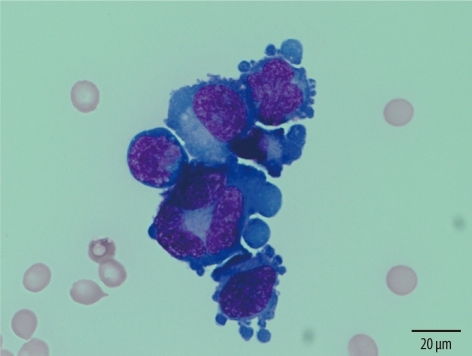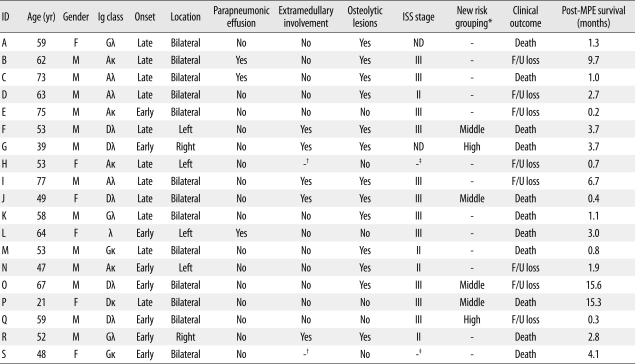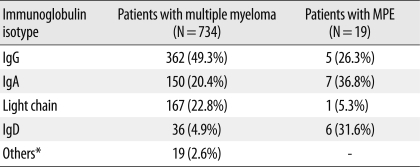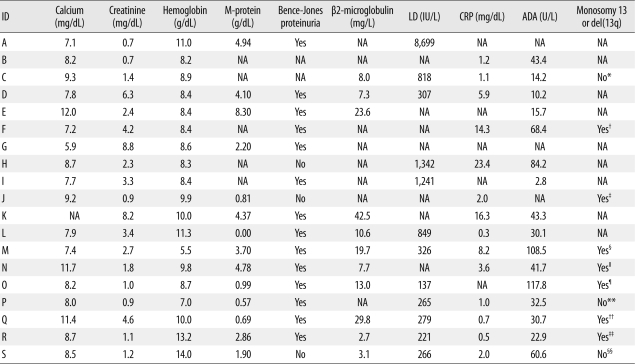1. Kintzer JS, Rosenow EC, Kyle RA. Thoracic and pulmonary abnormalities in multiple myeloma. A review of 958 cases. Arch Intern Med. 1978; 138:727–730. PMID:
646535.

2. Alexandrakis MG, Passam FH, Kyriakou DS, Bouros D. Pleural effusions in hematologic malignancies. Chest. 2004; 125:1546–1555. PMID:
15078773.

3. Rodriguez JN, Pereira A, Martinez JC, Conde J, Pujol E. Pleural effusion in multiple myeloma. Chest. 1994; 105:622–624. PMID:
8306782.

4. Meoli A, Willsie S, Fiorella R. Myelomatous pleural effusion. South Med J. 1997; 90:65–68. PMID:
9003828.

5. Kim YJ, Kim SJ, Min K, Kim HY, Kim HJ, Lee YK, et al. Multiple myeloma with myelomatous pleural effusion: a case report and review of literature. Acta Haematol. 2008; 120:108–111. PMID:
18957845.
6. Kamble R, Wilson CS, Fassas A, Desikan R, Siegel DS, Tricot G, et al. Malignant pleural effusion of multiple myeloma: prognostic factors and outcome. Leuk Lymphoma. 2005; 46:1137–1142. PMID:
16085553.

7. International Myeloma Working Group. Criteria for the classification of monoclonal gammopathies, multiple myeloma and related disorders: a report of the International Myeloma Working Group. Br J Haematol. 2003; 121:749–757. PMID:
12780789.
8. Munshi NC, Longo DL, Anderson KC. Fauci AS, Braunwald E, Kasper DL, editors. Plasma cell disorders. Harrison's principles of internal medicine. 2008. 17th ed. New York, USA: McGraw Hill Medical;p. 700–707.
9. Shimamoto Y, Anami Y, Yamaguchi M. A new risk grouping for IgD myeloma based on analysis of 165 Japanese patients. Eur J Haematol. 1991; 47:262–267. PMID:
1954984.

10. Chen ML, Yu WC, Lam CW, Au KM, Kong FY, Wo Cham AY. Diagnostic value of pleural fluid adenosine deaminase activity in tuberculous pleurisy. Clin Chim Acta. 2004; 341:101–107. PMID:
14967164.

11. Zaric B, Kuruc V, Milovancev A, Markovic M, Sarcev T, Canak V, et al. Differential diagnosis of tuberculosis and malignant pleural effusions: what is the role of adenosine deaminase? Lung. 2008; 186:233–240. PMID:
18357489.
12. Porcel JM, Aleman C, Bielsa S, Sarrapio J, Fernandez de Sevilla T, Esquerda A. A decision tree for differentiating tuberculous from malignant pleural effusions. Respir Med. 2008; 102:1159–1164. PMID:
18573650.

13. McKenna RW, Kyle RA, Kuehl WM, Grogan TM, Harris NL, Coupland RW. Swerdlow SH, Campo E, Harris NL, editors. Plasma cell neoplasms. WHO classification of tumours of haematopoietic and lymphoid tissues. 2008. 4th ed. Lyon, France: IARC;p. 200–213.
14. Jancelewicz Z, Takatsuki K, Sugai S, Pruzanski W. IgD multiple myeloma. Review of 133 cases. Arch Intern Med. 1975; 135:87–93. PMID:
1111472.

15. Blade J, Lust JA, Kyle RA. Immunoglobulin D multiple myeloma: presenting features, response to therapy, and survival in a series of 53 cases. J Clin Oncol. 1994; 12:2398–2404. PMID:
7964956.
16. Pruzanski W, Rother I. IgD plasma cell neoplasia: clinical manifestations and characteristic features. Can Med Assoc J. 1970; 102:1061–1065. PMID:
5000054.
17. Johnston JB, Weinerman B, Cooney T, Bowman DM, Pettigrew NM, Orr K. IgD kappa plasma cell dyscrasias: extraosseous manifestations including isolated leptomeningitis. Am J Clin Pathol. 1982; 77:60–65. PMID:
6798858.
18. Kamal MK, Williams E, Poskitt TR. IgD myeloma with malignant pleural effusion. South Med J. 1987; 80:657–658. PMID:
3576276.

19. Kim YM, Lee KK, Oh HS, Park SK, Won JH, Hong DS, et al. Myelomatous effusion with poor response to chemotherapy. J Korean Med Sci. 2000; 15:243–246. PMID:
10803706.

20. Natori K, Izumi H, Nagase D, Fujimoto Y, Ishihara S, Kato M, et al. IgD myeloma indicated by plasma cells in the peripheral blood and massive pleural effusion. Ann Hematol. 2008; 87:587–589. PMID:
18265984.

21. Yokoyama T, Tanaka A, Kato S, Aizawa H. Multiple myeloma presenting initially with pleural effusion and a unique paraspinal tumor in the thorax. Intern Med. 2008; 47:1917–1920. PMID:
18981637.

22. Chang H, Chou WC, Lee SY, Huang JY, Hung YH. Myelomatous pleural effusion in a patient with plasmablastic myeloma: a case report. Diagn Cytopathol. 2009; 37:205–207. PMID:
19170175.

23. Cristalli G, Costanzi S, Lambertucci C, Lupidi G, Vittori S, Volpini R, et al. Adenosine deaminase: functional implications and different classes of inhibitors. Med Res Rev. 2001; 21:105–128. PMID:
11223861.

24. Meier J, Coleman MS, Hutton JJ. Adenosine deaminase activity in peripheral blood cells of patients with haematological malignancies. Br J Cancer. 1976; 33:312–319. PMID:
1063590.

25. Ohata M, Masuda I, Nonaka K, Sugiura K. Combination assay of IAP and ADA in hematologic malignancies. Rinsho Byori. 1990; 38:703–710. PMID:
2381093.
26. Shaughnessy J Jr, Tian E, Sawyer J, McCoy J, Tricot G, Jacobson J, et al. Prognostic impact of cytogenetic and interphase fluorescence in situ hybridization-defined chromosome 13 deletion in multiple myeloma: early results of total therapy II. Br J Haematol. 2003; 120:44–52. PMID:
12492575.

27. Chiecchio L, Protheroe RKM, Ibrahim AH, Cheung KL, Rudduck C, Dagrada GP, et al. Deletion of chromosome 13 detected by conventional cytogenetics is a critical prognostic factor in myeloma. Leukemia. 2006; 20:1610–1617. PMID:
16826223.









 PDF
PDF ePub
ePub Citation
Citation Print
Print


 XML Download
XML Download